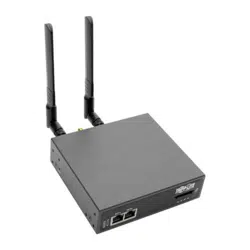Loading ...
Loading ...
Loading ...

155
8. Power, Environment and Digital I/O
• When you select a network UPS connection, the corresponding host name/description you set up for that connection will
be entered as the Name and Description for the power device. Alternately, if you selected to Connect Via USB or serial
connection, you will need to enter a Name and Description for the power device (these details will also be used to create a
new managed device entry for the serial/USB-connected UPS devices).
• Enter the login details. This Username and Password is used by Secondary units of this UPS (i.e. other computers that are
drawing power through this UPS) to connect to the console server to monitor the UPS status so they can shut themselves
down when battery power is low. Monitoring will typically be performed using the upsmon client running on the Secondary
server (refer to 8.2.3 Controlling UPS Powered Computers).
Note: These login credentials are not related to the users and access privileges configured in Serial & Networks: Users & Groups.
• Select the action to take when UPS battery power becomes critical (i.e. shut down the UPS or shut down all managed UPS
systems) or simply allow the unit(s) to run until failure.
Note: The shutdown script /etc/scripts/ups-shutdown can be customized in the event of a critical power failure (when the UPS battery runs
out). In doing so, you can program the console server to perform final shutdown actions before backup power is lost. However, it is easier
to perform final shutdown actions by triggering auto-response on the UPS. Refer to 7. Alerts, Auto-Response and Logging for more
information.
• If you have multiple UPS systems and require them to be shut down in a specific order, specify the Shutdown Order for
this UPS. This is a whole positive number, or -1. 0s are shut down first, then 1s, 2s, etc. -1s are not shut down at all. The
default setting is 0.
• Select the Driver that will be used to communicate with the UPS.
• Click New Options in Driver Options if you need to set driver-specific options for your selected NUT driver and hardware
combination (more details can be found at http://www.networkupstools.org/doc).
• Check Log Status and specify the Log Rate (minutes between samples) if you wish to have the status from this UPS be
logged. These logs can then be viewed from the Status: UPS Status screen.
• If Nagios services are enabled, you will be presented with an option for Nagios monitoring. Check the Enable Nagios
checkbox to allow the UPS to be monitored using Nagios central management.
• Check Enable Shutdown Script if the UPS is providing power to the console server. In the event of a critical power failure,
you can perform any final shutdown actions on the console server before power is lost. This is done by placing a custom
script in /etc/config/scripts/ups-shutdown (you may use the provided /etc/scripts/ups-shutdown as a template). This
script is only run when the UPS reaches critical battery status.
• Click Apply.
Note: You can also customize the upsmon, upsd and upsc settings for this UPS hardware directly from the command line.
Loading ...
Loading ...
Loading ...
